Rhodes
Q43048Rhodes (Greek Ῥόδος): island in the Aegean Sea, originally divided between Ialysus, Kameiros und Lindos, but later one single city-state.

According to an ancient Greek myth, the god Zeus had decided to divide his kingdom among the gods of Olympus, and awarded a fertile island to Helios, the sun god. He named his new possession after a nymph who lived there, Rhode; they would marry and have seven sons. The first of these Heliadai had three sons, who founded three cities: Ialysus, Kameiros, and Lindos.
Prehistory
Rhodes was already inhabited in the Neolithic, Chalcolithic, and Early Bronze Age and had cultural contacts with the Minoans from Crete, who may have founded the Trianda settlement (in the northwest) in the sixteenth century. In the fourteenth century, the Mycenaean Greeks arrived and settled on Rhodes. Many tombs date back to this period.
Other Greeks continued to the east and settled on Cyprus: Rhodes had become an important node in the interregional trade network of the Bronze Age. Several shipwrecks off the Lycian coast offer evidence for the products that were exchanged in this period.
 Rhodes, Mycenaean cup (LH IIIa2) |
 Rhodes, Mycenaean jar with a bull (LH IIIa2) |
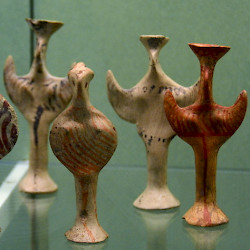 Rhodes, Mycenaean "phi" and "psi" figurines |
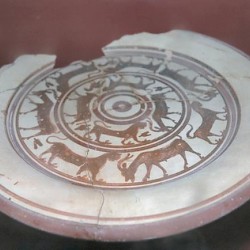 Taucheira, Fruit dish from Rhodes |
Archaic Age
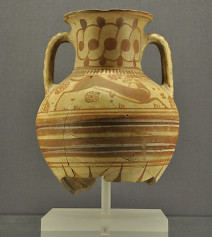
In the twelfth century BCE, the Bronze Age trade network collapsed, a process that may have been triggered by the roaming Sea People, although they may have been a product of this collapse as well. We cannot know what was cause and what was effect. What is clear, however, is that the Iron Age was comparatively poor.
In this period, the cities of Rhodes (Ialysus, Kameiros, and Lindos) where founded. When people started to write, it was in the Dorian dialect of the Greek language. That they belonged to the world known as Greek, can be deduced from Homer's Iliad, where the Rhodians are mentioned as one of the nations taking part in the Trojan War. That their leader, Tlepolomus, is killed in action by a Lycian, Sarpedon, may betray an old tradition.
The division of Rhodes into three cities is attributed to this Tlepolemus. According to a famous section in the Histories of Herodotus, the three cities of Rhodes collaborated with Kos and the mainland cities of Cnidus and Halicarnassus in a confederation that is known as the Doric Hexapolis (or Pentapolis, after Halicarnassus was expelled). Together, they organized athletic contests for Apollo.note
The cities prospered, because trade had resumed and the island was again an important node in the interregional network. Rhodian products often betray international influences (e.g., the type of pottery found in Phikelloura) and have been found on all Mediterranean shores. The Rhodians also founded colonies along the trade routes: Phaselis in eastern Lycia, Gela on Sicily in the west. The temple of Athena in Lindos was of superregional importance.
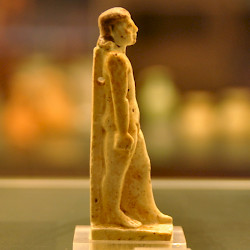 Rhodes, Egyptian-style statuette |
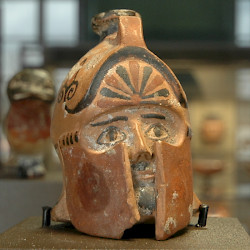 Rhodes, Head-shaped aryballos |
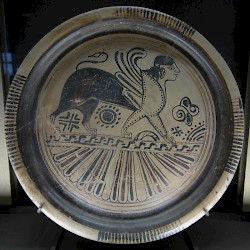 Rhodes, Dish with a sphinx |
 Rhodes, Amphora in Phikelloura style |
Classical Age
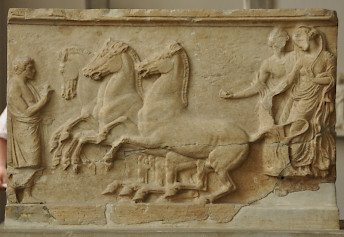
The second half of the sixth century witnessed the rise of the Persian or Achaemenid Empire, an event that must have mattered very much to the mercantile Rhodians. It is probably no coincidence that king Amasis of Egypt, whose kingdom was threatened, was interested in collaborating with the Rhodians.note In 499, they joined the Ionian Revolt, but were rapidly subject to the Persians again. The Persian commander was the Datis who would be the leader of the Persian troops in the battle of Marathon in 490 BCE.
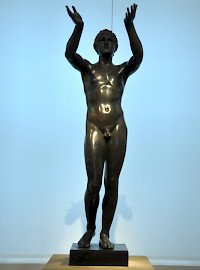
Twelve years later, the Rhodian cities joined the Delian League, the anti-Persian league founded by the Athens, which gradually became an Athenian empire. In 413, the Decelean or Ionian War broke out, which meant the end of Athens. The city surrendered to the Spartans in 404. During this war, the Rhodians reconsidered their position and the three cities joined forces: they founded a new city on the northern top of the island, Rhodes. It was built on a Hippodamian Plan, i.e., as a gridiron. The new city was a great success and acquired some land on the Asian mainland (the Rhodian Peraea).
The Athenians had been defeated but they managed to recover during the Corinthian War (395-387). The pro-Spartan faction on Rhodes was overthrown by pro-Athenian politicians, and when the peace Peace of Antalcidas was signed in 387, Rhodes maintained its independence, although it was allied to the Carian satrap Maussolus of Halicarnassus. In Greek politics, it first sided with Thebes against the Athenian Second Delian League, and supported Philip of Macedonia against Thebes and Athens. All the same, the island had contacts with every country in the eastern Mediterranean: two famous mercenary leaders in the Persian Empire, Mentor and Memnon, were Rhodians.
Hellenistic Age
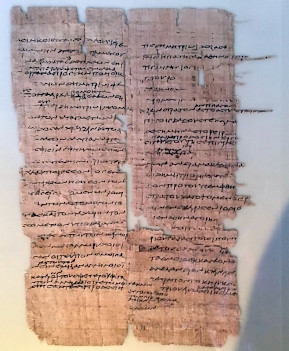
After the death of the Macedonian conqueror Alexander the Great in 323 BCE, Rhodes suddenly was one of the centers of political life. Alexander’s successors were fighting for a share of what had been conquered and the island was of great strategic importance: who controlled Rhodes, controlled the entrance to the Aegean Sea, and controlled the route from Greece and Macedonia to the eastern Mediterranean. When Demetrius, the son of Alexander’s general (strategos) Antigonus the One-Eyed, tried to conquer independent Rhodes in 305/304, the siege lasted for a year (text); he achieved nothing but accepted the title Poliorcetes, “besieger of cities”, nevertheless.
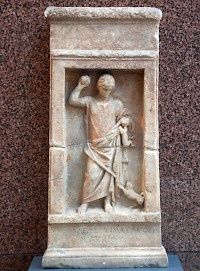
The Rhodians financed the construction of a giant statue of Helios, the famous Colossus of Rhodes, reportedly by selling Demetrius’ siege engines. This wonder of the ancient world collapsed in 227 BCE after an earthquake. Several Greek cities and Asian kingdoms contributed to the rebuilding of Rhodes, because everyone wanted to gain some influence over here.note
In the second half of the third century, while Ptolemaic Egypt lost its naval supremacy, its ally Rhodes became the strongest naval power in the Aegean world. It expanded its mainland territories but also gained control of several islands, such as Karpathos.
After the Fifth Syrian War (202-195 BCE), Ptolemaic Egypt was really in decline and Rhodes allied itself to the new superpower: Rome, which had already defeated Carthage and would defeat Macedonia in the Second Macedonian War (200-197). In the Syrian War (192-188), it defeated the Seleucid Empire. Rhodes was Rome’s loyal ally and was rewarded in 188 BCE with possessions in Lycia and Caria.
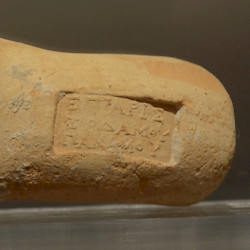 Gadara, Handle of a Rhodian amphora |
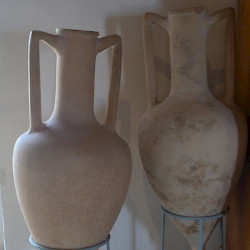 Old Paphos, Two Rhodian amphoras |
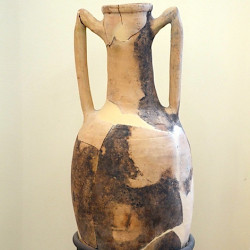 Corfu, Palaiopolis, Rhodian amphora |
 Nicosia, Handle of a Rhodian amphora |
In 168 BCE, during the Third Macedonian War, Rhodes tried to mediate between Rome and the Macedonian king Perseus instead of unconditionally supporting the Romans. When the latter had defeated the Macedonians at Pydna, the island was out of favor and the Senate even considered war. In the end, it decided to establish a free port on the isle of Delos, which meant that slaves were no longer sold on Rhodes: a blow for the economy. The island lost its mainland territories. In 164, Rhodes entered into an unequal alliance with Rome, which meant the end of his role as an independent power.
Yet, it recovered. Its fleet was still important and it remained a hub in a long-distance trade network, especially as center of the grain trade, which became increasingly important in the first century BCE, when Rome became a very large center. When the Seleucid Empire started to disintegrate, it was the Rhodians who took over the task of fighting piracy.
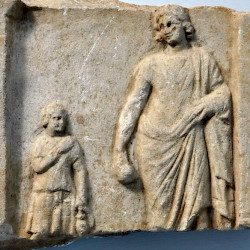 Rhodes, Tombstone of a Woman |
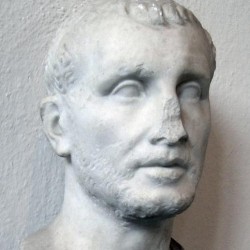 Rhodes, Portrait of Posidonius of Apamea |
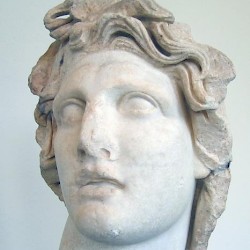 Rhodes, Portrait of Alexander the Great as Helios |
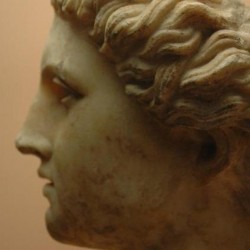 Rhodes, Portrait of Alexander the Great |
Roman Age
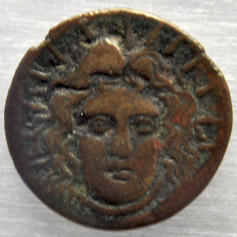
During the First Mithridatic War (89-85 BCE), Rhodes was one of the main centers of fighting, but it held out. This was repeated in the war that broke out in 43 BCE, when the assassins of Julius Caesar were fighting against Mark Antony and Octavian. Caesar’s murderer Cassius conquered and looted the city of Rhodes. Again, it survived and it was the place where, several years later, Octavian, after he had defeated his former comrade-in-arms Mark Antony, met Mark Antony’s former ally king Herod. Several years later, when Octavian had become emperor, his stepson Tiberius, the future emperor, retreated to Rhodes.
The island was now part of the Roman world, although it was not officially incorporated in the empire until 74 CE, together with Lycia. Rhodes now belonged to the province of Lycia and Pamphylia. The island still had famous schools for sculptors and philosophers and continued to prosper, although it suffered heavily from an earthquake in 142 CE.
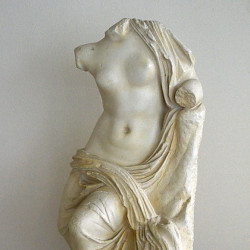 Rhodes, Statue of Aphrodite (cast) |
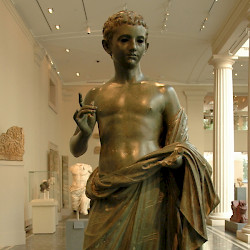 Rhodes, Statue of young man |
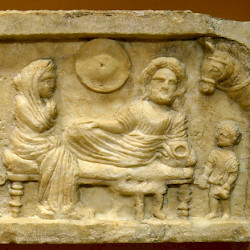 Rhodes, Relief of a Funeral Meal |
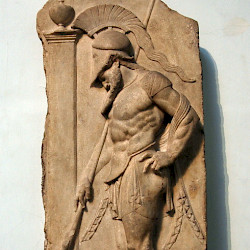 Rhodes, Relief of a soldier (archaizing) |
Late Antiquity
In the second half of the fourth century, the Roman Empire fell apart in two parts. Rhodes became part of the Eastern or Byzantine Empire. In the course of the next century, the fifth, its inhabitants would see the demise of the western half. When in the 460s a final and ill-fated attempt was made to reverse this decline, control over the eastern waters was temporarily relaxed and in 469, the island was probably plundered by Isaurian pirates. However, the Byzantine Empire survived.
In 653/654, however, an Arab fleet defeated the Byzantine navy in the Rhodian waters and the island was plundered by Arabs. From now on, the island was one of the fronts in the wars between the Byzantines and the Caliphate of Damascus.